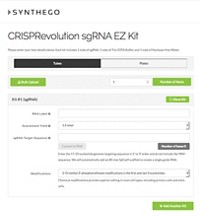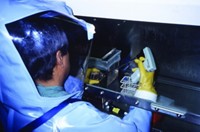Advertisement
Grab your lab coat. Let's get started
Welcome!
Welcome!
Create an account below to get 6 C&EN articles per month, receive newsletters and more - all free.
It seems this is your first time logging in online. Please enter the following information to continue.
As an ACS member you automatically get access to this site. All we need is few more details to create your reading experience.
Not you? Sign in with a different account.
Not you? Sign in with a different account.
ERROR 1
ERROR 1
ERROR 2
ERROR 2
ERROR 2
ERROR 2
ERROR 2
Password and Confirm password must match.
If you have an ACS member number, please enter it here so we can link this account to your membership. (optional)
ERROR 2
ACS values your privacy. By submitting your information, you are gaining access to C&EN and subscribing to our weekly newsletter. We use the information you provide to make your reading experience better, and we will never sell your data to third party members.
Biological Chemistry
Avoiding Frankenstein
Efforts are under way to mitigate the risk that good life sciences research could be put to bad use
by Britt E. Erickson
October 25, 2010
| A version of this story appeared in
Volume 88, Issue 43

Advances in the life sciences have given researchers the ability to alter living systems at a fundamental level. It is now possible to redesign biological organisms, assemble simple chemicals to form new cells, and create DNA with six, eight, or 12 bases instead of the usual four.
The potential applications of those capabilities are endless. They promise new drugs and drug delivery systems, biofuels from sunlight, and organisms to clean up oil spills. But with new kinds of biological diversity and novel life forms come biosafety and biosecurity risks.
“Over the past 10 years, there’s been a growing recognition of the need to consider how the new information resulting from life sciences research could, in the wrong hands, be misused to pose a threat to public health and to the security of all of our nations,” said David R. Franz, vice president and chief biological scientist at the Midwest Research Institute. Franz was speaking last month during a webinar aimed at raising international awareness of the risks posed by life sciences research.
The event was hosted by the National Science Advisory Board for Biosecurity (NSABB), a government-wide group managed by the National Institutes of Health. NSABB advises the Department of Health & Human Services (HHS) on mitigating the potential misuse of life sciences research.
Nearly all life sciences research could be misused to pose a public health threat, several panelists noted. Such research, which is intended to advance scientific understanding and improve public health, is often called dual-use research.
It is impractical, however, to review all life sciences research for the potential for misuse. “In order to mitigate risks and at the same time support progress in the life sciences, it is necessary to identify research that has the highest potential for generating information that could be misused,” Franz stressed. NSABB has suggested that such research be called dual-use research of concern.
But the line between dual-use research and dual-use research of concern is fuzzy. “Many researchers are aware that their work might have potential for dual use, but they don’t have the right tools or ways to check whether their work is of concern,” noted Markus Schmidt, cofounder of the Organization for International Dialogue & Conflict Management, in Vienna, Austria. “More explicit guidelines or training would help them to make a decision.”
Such guidelines are currently being developed in the U.S., said Amy P. Patterson, acting associate director for science policy at NIH. “The U.S. government has been very busy trying to refine the oversight framework to respond to scientific advances in a manner that would promote responsible science but at the same time ensure the rapid progress of scientific advances.” Policy at both the research institution level and federal level “is well under way and is based very much on the recommendations of NSABB,” Patterson noted.
Those recommendations were finalized by NSABB in its 2007 report “A Proposed Framework for the Oversight of Dual Use Life Sciences Research.” The report provided strategies for minimizing the misuse of research information, including tips for outreach, education, promoting awareness, sensitizing relevant communities, risk assessment, and risk management. It also provided guidelines for recognizing research that has dual-use potential.

The report proposed the following criterion for identifying dual-use research of concern: “research that, based on current understanding, can be reasonably anticipated to provide knowledge, products, or technologies that could be directly misapplied by others to pose a threat to public health and safety, agricultural crops and other plants, animals, the environment, or materiel.”
In addition, the report identified broad categories of information with high potential for misuse. Some of those categories included enhancing the harmful consequences of a biological agent or toxin; disrupting immunity without clinical or agricultural justification; compromising the ability to detect, treat, or prevent disease; and generating a novel pathogenic agent or toxin or one that has been eradicated or is extinct.
When an experiment is deemed dual-use research of concern, “the first thing to do is talk to colleagues and talk to your supervisor,” said Gerald W. Parker, principal deputy assistant secretary in HHS’s Office of the Assistant Secretary for Preparedness & Response. The work might require broader review at the institutional level to determine whether risk mitigation practices and communications are necessary, he noted.
NIH is also revising a landmark document from the 1970s that provides an oversight framework for the safe and ethical conduct of research involving recombinant DNA molecules. The policy “is currently under revision to take into account advances in synthetic biology and to explicitly address research with synthetic nucleic acid molecules,” Patterson said.
Earlier this month, HHS issued voluntary guidance for providers of synthetic double-stranded DNA to minimize the risk that synthetic DNA will be deliberately misused. The guidance recommends that providers screen customer information and purchased DNA sequences for suspicious activity, and it clarifies what to do with a suspicious order.
Other countries are also trying to get a handle on rapidly advancing areas in the life sciences. The webinar provided a forum for scientists from around the world to share their thoughts on the dual-use dilemma.
“From a European perspective, the definition of ‘dual use’ is a bit broader. It is not limited to biosafety and biosecurity issues,” said Mihail Kritikos, a research program manager for the Research Directorate General of the European Commission, in Brussels. “We consider surveillance technologies and detection technologies as potential fields for dual use or misuse. For the European Commission, dual use is any type of research that might be used for unethical purposes.”
However dual-use research is defined, researchers in the life sciences should at least be aware of the concept, several panelists stressed. And just because a project is deemed dual-use research of concern doesn’t mean it should not be conducted, they said.
The idea is to build awareness, not to direct and counter science, commented Stuart B. Levy, director of the Center for Adaptation Genetics & Drug Resistance and a professor at Tufts University School of Medicine. Levy and Franz cochair the NSABB Working Group on International Engagement.
Communication of research results with dual-use potential should also not be censored, participants agreed. Several of them pointed to a statement issued in 2003 by editors and publishers of nearly 20 top scientific journals (Proc. Natl. Acad. Sci. USA 2003, 100, 1464).
The group acknowledged that there are legitimate concerns raised by the potential for published data to be misused, particularly for journals that deal with microbiology, infectious agents, public health, and agricultural systems. But at the same time, they wrote that the integrity of the scientific process must be protected by publishing high-quality papers with sufficient detail to be reproduced.
“The journals did not agree to do anything to damage that process,” noted Linda J. Miller, associate dean for basic sciences at New York University School of Medicine and former U.S. executive editor of Nature. “In other words, they were not going to remove a method section and publish the rest of the paper because the method looked like it was of great concern. They would just not publish the paper.”
Today, most journals and publishers have set up internal processes that involve special review of papers that are of dual-use concern. But so far, only a handful of papers have actually raised alarm bells. One of them was a paper in Science on the characterization of the reconstruction of the 1918 pandemic flu virus (2005, 310, 77).
Although the paper was of great concern, it was published. If peer reviewers recommend publishing a paper, it is published even if the risks of misuse far outweigh the benefits, Miller stressed. “There are minor modifications that are made to papers and the publishing process to make sure that the public understands that biosafety measures were taken into account,” she said.
Miller referred to a directive issued under the Reagan Administration in 1985, which she says still holds true. That directive reads: “to the maximum extent possible, the products of fundamental research remain unrestricted. … No restrictions may be placed upon the conduct or reporting of federally-funded fundamental research that has not received national security classification.”
But research is a global enterprise, Miller noted. She encouraged more awareness internationally so that authors worldwide can confidently alert editors when they are seeking to publish dual-use research of concern.
Several European countries have been promoting awareness of dual-use research, and some, such as the Netherlands, have adopted codes of conduct, said Andrzej Górski, vice president of the Polish Academy of Sciences.
The World Health Organization has also been raising awareness in this area. In 2006, WHO organized a workshop on dual-use research in the eastern Mediterranean, and this year, it is providing training in Kazakhstan for developing countries, noted Guénaël R. Rodier, director of communicable diseases, health security, and environment at WHO.
The webinar helped to expand the network of individuals and organizations from around the world involved in sharing perspectives about dual-use research. “Promoting the responsible conduct of research with dual-use potential is critical to sustain progress in the life sciences,” Górski said. “I think we can all agree on how essential science progress is.”




Join the conversation
Contact the reporter
Submit a Letter to the Editor for publication
Engage with us on Twitter